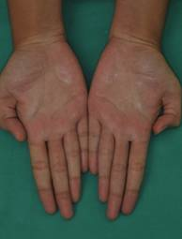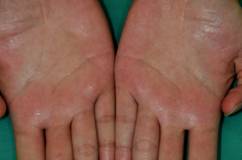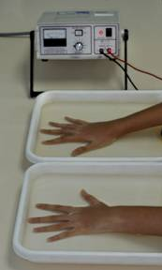What is hyperhidrosis?
Hyperhidrosis or excessive sweating is a condition where there is sweating beyond the normal need of the body. The sites most commonly affected are the palms (palmar hyperhidrosis), feet (plantar hyperhidrosis) and armpits (axillary hyperhidrosis). Hyperhidrosis is a fairly common condition which affects people of all races. It may be familial, usually begins in childhood or adolescence and may persist for some years. Although it is not associated with mortality, it can have a significant effect on the quality of life in its sufferers.
 |
 |
What is the cause of hyperhidrosis?
The exact cause of hyperhidrosis is unknown. Sweat is produced by sweat glands located in the skin with the highest concentration on the palms and soles. The activity of the sweat glands is under the control of the sympathetic nervous system which might be overactive in someone with hyperhidrosis.
There are various ways to classify hyperhidrosis, one of which is to divide it into primary or secondary hyperhidrosis. In primary hyperhidrosis the underlying aetiology is not known. It tends to be localized with a predilection for hands, feet, armpits and face. Secondary hyperhidrosis is due to an underlying condition and generally affects the whole body. Causes include hyperthyroidism, infections such as tuberculosis and malignancies such as lymphoma. Other causes are obesity, menopause and diabetes mellitus. Hyperhidrosis may be aggravated by heat, emotions, exercise, fever and spicy food. Sweating usually decreases at night time and may disappear altogether during sleep.
What are the signs and symptoms of hyperhidrosis?
Due to excessive sweating, sufferers may show the following:
- Frequent wiping of hands
- Avoiding hand shaking
- Difficulty in handling or gripping items, writing, playing musical instruments
- Difficulty in engaging in intimate relationships and socializing
- Distressed, anxious
- Embarrassing social situations when clothing become damp around the armpits
- Unpleasant odour from the feet and armpits
What are the complications of hyperhidrosis?
Wet areas may on the skin become soggy and are prone to cracking and infections
What are the treatments available for hyperhidrosis?
As far as possible, treatment should be initiated in a step ladder approach starting from the least invasive option.
General measures
- Wear loose clothing made of fabric that does not stain
- Apply talcum powder after showering
- Wear cotton socks and change them several times a day
- Expose feet as often as possible
Specific measures
- Topical antiperspirants
An antiperspirant is an astringent that decreases eccrine and apocrine sweat secretion. Topical antiperspirant contains aluminium chloride hexahydrate. Aluminium salts collect in the sweat ducts and obstruct them resulting in reduction in sweating. Results may be satisfactory especially for patients with axillary hyperhidrosis. This medication is applied onto the affected area which must be clean and dry just before bedtime, then left overnight before washing it off the following morning. It requires an initial daily application of 7-10 nights in a row, then once a week for maintenance. Side effects are mainly irritation which may be overcome by reducing the frequency of application. - Iontophoresis
Iontophoresis is a device which passes direct electricity through the skin using tap water to block the sweat glands. Total treatment duration is about 20 minutes at an initial frequency of every 2-3 days, then stretched till once every 2 weeks. This mode of treatment is contraindicated in patients who are pregnant, those with severe skin lesions or local wound, and those with pacemakers and abnormal heart rhythm (cardiac arrhythmias). It may cause transient tingling sensation and irritation.

- Oral medications
The preglandular neurotransmitter for sweat secretion is acetylcholine. Anticholinergics are drugs that inhibit the binding of acetylcholine to their receptors which results in decreased production of sweat. Examples of anticholinergics are glycopyrrolate and propantheline bromide. They are not commonly used due to side effects such as dry mouth, blurring of vision, constipation, difficulty in passing urine, dizziness, palpitations and insomnia. - Botox (botulinum toxin)
Botox has been around for many years to treat muscle spasms and wrinkles. It consists of proteins that permanently block the nerve endings that supply the eccrine glands, thus preventing the glands from producing sweat. Treatment involves injection into the affected areas and needs to be repeated every 4-5 months. Drawbacks include pain and temporary muscle weakness. - Surgery
Endoscopic thoracic sympathectomy (ETS)
Hyperhidrosis is due to overactivity of sympathetic nerves located in the chest cavity. Sympathectomy is an operation which destroys part of the nerve supply to the sweat glands in the skin. This procedure should only be performed after all the other measures have failed and after consultation with the surgeon. The surgeon makes small incisions just below the armpit and inserts a special endoscopic instrument into the chest. The lung is briefly deflated for better visualization followed by destruction of the nerve. The extent or level of the sympathetic blockade varies according to the type of hyperhidrosis. The most common side effect of ETS is compensatory sweating, which is an exaggerated sweating that may occur in the lower chest, back, abdomen, thighs and legs. Other complications of surgery include bleeding, infection, rib pain and pneumothorax (collapsed lung).
What should I do if I have symptoms to suggest hyperhidrosis?
A person with the symptoms described above should first consult a doctor to confirm the diagnosis. Based on the assessment, the doctor will decide if the patient requires further tests to identify the underlying cause and further treatment of hyperhidrosis.
| Last Reviewed | : | 23 August 2019 |
| Writer | : | Dr. Noorlaily Mohd Noor |
| Accreditor | : | Datin Dr. Asmah Johar |
| Reviewer | : | Dr. Nazatul Shima bt. Abd Rahim |







